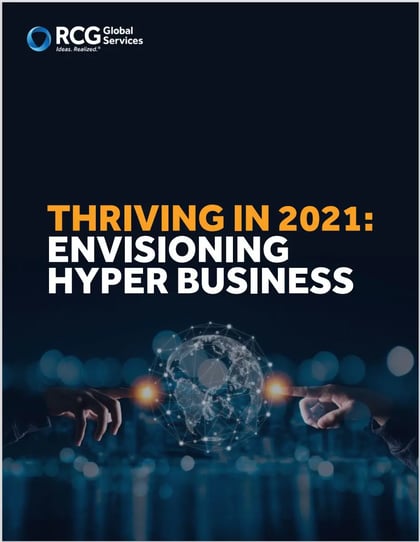Thriving in 2021: Envisioning Hyper Business
What can you do to accelerate your organization’s digital transformation progress to ensure that you’ll be on target in meeting the challenges of the future?
Transformation involves change, and change is rarely easy.

Although, in many ways, it seemed to be the year that would never end, organizations worked at a frantic pace to accelerate their digital transformation and virtually meet the new and evolving expectations of their customers, workforce, and partners.
Given the importance of digital transformation, it’s no surprise that it has become a standard component of the global business lexicon. It’s also no surprise that most organizations are actively working to digitally transform – at least to some degree.
What can you do to accelerate your organization’s digital transformation progress to ensure that you’ll be on target in meeting the challenges of the future?
We’ve identified four strategic areas that will help organizations successfully achieve business at the speed of now – hyper business.
“Digital transformation is about sweeping change. It changes everything about how products [and services] are designed, manufactured, sold, delivered, and serviced—and it forces CEOs to rethink how companies execute, with new business processes, management practices, and information systems, as well as everything about the nature of customer relationships.” – Thomas M Siebel, McKinsey Quarterly
Hyper Personalization

The challenge facing many companies today is that workers and customers engage mobile and web applications with high expectations. They expect applications to be intuitive, easy to use, and tailored to meet their individual circumstances. Mega-online retailers, digital natives, and video games set these expectations for customer experiences regardless of the industry – financial services, healthcare, insurance, hospitality, travel, and retail.
The level of personalization required to deliver these types of stellar customer experiences requires more than a refined technical architecture. And, unfortunately, the most sophisticated systems and toolsets designed today won’t set apart a mobile or web app in the market and drive greater impacts if the user experience is cumbersome. That’s why the first tenet in your design philosophy should be empathy.
New and updated applications should focus on creating comfortable, intuitive and engaging points of entry for workers and customers. Effective people-centric solutions are created by technologists who have emotional intelligence – people with strong empathy skills – who understand and enable a digital-first approach, and who effectively deploy technology to influence people’s actions.
Hyper-personalization employs real-time data and AI to deliver relevant information, product recommendations, and services to individual customers. Using intelligent analytics via streaming real-time data and AI, hyper-personalization uncovers relevant insights to create hyper-customization – offers targeted for one customer. Rather than one offer for many customers or a few offers for targeted personas, hyper-personalization provides one or more offers for one customer. Additionally, better customer management through hyper-personalization can yield better insight for decision-making, reduced churn, optimized marketing investment, better targeting and segmentation, and delivering a better overall customer experience. The possibilities and the valuable outcomes are nearly endless in marketing, customer experience, and most other areas of your business model.
Hyper-personalization can be as simple as optimizing experiences with improved communication, education, and self-service functions.
“Companies can leverage analytics to become more familiar with customers and their requirements and to optimize communication so appropriate messages are pushed to them at the most opportune time and place.” Dr. Rob Nelson, The Sentient Enterprise: The New Imperative in Business Decision-Making and Customer and Operations Management.
“B2B sellers deepen buyer relationships with help from AI,” Forrester Research, Predictions 2021 Accelerating Out of the Crisis. “As the amount of buyer engagement data increases, AI can surface patterns, guide the seller to the next best action, and identify the buyer’s preferred channel.”
Healthcare Examples:
For example, the successful, next-generation healthcare organization will have customer engagement as their primary strategic initiative. If they do not, they will either close or be consumed by competitors. Recently, RCG worked with a healthcare organization to:
- Enable team member scheduling, certification tracking, and corporate communications and
- Better engage patients by providing real-time updates and communications regarding COVID-19.
Financial Services Examples:
Similarly, in financial services organizations, developing a more intimate and comprehensive relationship with customers offers an abundance of both short-term and long-term benefits such as:
- Reevaluating Credit: Using traditional and non-traditional sources of information to identify behavioral patterns in more accurately determining credit worthiness
- Speeding-Up the Loan Process: Leveraging more efficient use of internal and external data, coupled with algorithms and AI, to reduce the time to loan approval
- Enhancing Compliance: Using technology to automate auditing, ensure compliance, and produce required documentation more accurately and quickly
- Identifying Cross-Sell/Upsell Opportunities: Triggering outreach for new revenue opportunities based on more intimate knowledge of customers
Hyper Localization
“A hyperlocal delivery model can be defined as an online business model in which the on-demand needs of the customers are met through local offline shops via a digital platform. The demand for goods and services of customers like grocery, medicine, laundry service, etc. are met instantly.” Mindster
Location and contextual data can be used to create better customer experiences; create innovative new data-based products for your business; make more informed decisions in complex scenarios; carry out effective monitoring and analysis; optimize retail operations; understand customer behavior across different locations; detect even the smallest change and trigger immediate action; and extend your solutions to analyze the past, present, and the future.
A variety of technologies exist, such as beacons and sniffer tags, that can sense and track Wi-Fi devices every ten milliseconds. When Wi-Fi devices are detected, they capture and encrypt the time, location, and a unique device ID or even an identified app. You can choose to:
- Send data over existing or dedicated networks to a cloud-based data repository.
- Position and aggregate data for delivery, providing the processed data in the form of a data feed.
- Ingest the data feeds into advanced analytics tools and machine learning models to trigger events, alerts, or notifications and drive better marketing, promotion, and personalization.
Why would you not want to gain a whole new perspective on your potential customers – an entirely new data set?
The location data can even be used to correlate active social media sentiments for potential service interventions. “Digital Pathways bring B2B marketers closer to buyers,” Forrester Research, Predictions 2021 Accelerating Out of the Crisis. There are many potential benefits beyond real-time customer promotion and personalization.
RCG has defined App Lifestyle Integration (ALI) – using the concept of high trust and low trust locations to deliver secure, engaging content and transactions based on who the user is, what their status is, where they are, and where they should be.
RCG recently created a mobile solution that applies ALI to generate revenue and provide transaction functionality for universities. The app supports transactions with the university and university approved vendors for goods and services such as meal plans, books, and events. It also supports location-based services and features such as identity-based room access and tracking. For more information about ALI, check out Dameon Bryant’s video, App Lifestyle Integration Improves the Mobile Experience.
Hyper Automation

“Hyper automation is irreversible and inevitable. Everything that can be automated will be automated. Competitive pressures for efficiency, efficacy and business agility are forcing organizations to address it.” Gartner
AI, RPA, and Machine Learning allow us to automate processes and augment humans. This leads to higher efficiency and effectiveness in simple and complex tasks, enables higher productivity, and allows human workers to make better informed decisions to grow the business.
- Finding innovative ways to reduce costs
- Keeping focused on customer loyalty
- Adjusting to new consumer behaviors and trends
- Collaborating and kickstarting more creative thinking and solutions
- Focusing on data sharing
- Rethinking, reimagining, and redesigning the customer experience
- Finding ways to help people and partner in the response
- Examining and altering digital strategy
- Better enabling virtual business and work
- Automating manual processes to create resilience
Along with modern data architectures and continuous integration and deployment lifecycles, hyper-automation enables resilient business operations that are poised for
In the eBook, “5 Steps to Trailblaze your AI Journey, Shorten your Digital Transformation, and Raise your Digital Army to Win,” Dr. Rob Nelson shared these five key actions for achieving hyper automation:
“Workplace automation and AI are here to stay,” Forrester Research, Predictions 2021 Accelerating Out of the Crisis. “We forecast that by the end of 2021, one out of every four remote workers will be supported by new forms of automation.”
Recently, RCG worked with a large FinTech organization to accelerate the provisioning, allocation, and generation of data for testing processes which resulted in reduced time and effort in responding to compliance requirements and audits. We’ve also used RPA for an organization to develop the strategy for, design, and launch a bot initiative to automate simple and complex, cross[1]functional business processes. The engagement established and prioritized a pipeline of bots and in the first 6 months achieved a positive return on the investment.
Strategic Memory

Advancements in analytics and new automation tools have transformed many aspects of business today; however, the promises of hyper personalization, hyper-localization, and hyper-automation have not eliminated the need for skilled information workers to assess, decide, and act. Yet, these individuals often execute processes without a clear understanding of the larger strategic aims of the organization or of how their individual decisions and actions contribute to the company’s key strategic goals. In many cases, the average team member does not clearly understand the company’s current strategy and cannot keep pace with frequently changing priorities. This lack of “strategic awareness” is often at the core of operational and organizational dysfunction. It can directly lead to counter-productive efforts and increase time wasted on non-value-added activities.
In his eBook, Strategic Context – A Life Hack for your Business, Thomas Clarke shares, “Transformation is a journey, and attempting to change culture requires various tools and techniques. A successful strategy cannot be left to leadership to appreciate; it must be intentionally injected into the business operations and day-to-day decisions made.” Clarke defines a “life hack” concept to the challenge of strategic awareness in business decisions. In addition to simplifying the strategy, enhancing communications, and empowering resources, he suggests that organizations purposefully develop a “strategic memory” to ensure that as the enabling projects and programs are executed the strategy is ever-present as the North Star and ingrained in the process.
He suggests the following steps to simplify how we put strategy into action:
Recently, RCG worked with an Insurance organization that was facing pressures to utilize dynamic risk-based pricing and real-time quoting capabilities. We used RCG’s proprietary Digital Business Strategy & Roadmap approach to develop a holistic, dynamic roadmap with a focus on data-driven capabilities and enabling process and technologies. The strategy and roadmap were developed using the concepts of Strategic Memory. Subsequent projects and programs are actively and continuously pursuing the strategy as the North Star.
7 Fundamental Steps for Hyper Success

We’ve distilled knowledge gained through our real-world experience with client companies all around the globe into the seven following tips that you can use to move into hyperdrive and thrive in 2021.
#1 Establish a Living Digital Strategy
Your Digital Strategy should be developed using an agile approach that leverages a cross-functional team with a proven results-driven process. It should be based on an understanding of the current business model, related business processes, and applications. The result should include an actionable, scalable transformation plan to reach identified business results. Focus on achieving your business goals by defining, prioritizing, and architecting processes, applications, and technologies. RCG Strategy teams, for example, typically focus on the delivery of three customized digital business roadmap approaches:
- A directionally correct strategy that addresses “Where should I start?” This approach is useful for justifying an existing strategy and planning the supporting budget.
- Identification of opportunities and options for our clients that say, “Show me the possibilities, I’ll pick the path.” This approach is typically useful for use case identification and analysis of options.
- A guided journey that addresses the full digital transformation journey and solution. It is our holistic approach for clients who wish to define the goal and get there via the optimal route.
Beginning the journey with the end in sight is critical, and that is why you begin with business goals at the forefront of your strategic plan. Understanding current capabilities and gaps are crucial, and this isn’t something most organizations should self-assess — an outside viewpoint can be quite enlightening. Creating fast implementation cycles for selected priorities serves to quickly prove (or disprove) impact. Then you can scale the successful projects in a prioritized fashion.
#2 Design for Exceptional User Experiences
Forrester’s 2020 predictions focus heavily on adaptability and providing true value to your customers. Digital platforms are typically focused on the customer experience — the X. And the customer experience should be driving business decisions at the executive level. Your customers are dictating what they expect from you and how they want you to behave — even if they deliver that message through their decision to no longer be your customer.
The level of personalization required to deliver stellar customer experiences requires more than a refined technical architecture. New and updated applications should focus on creating comfortable, intuitive, and engaging points of entry for workers and customers.
The challenge facing many companies today is that workers and customers come to applications with high expectations. They expect applications to be intuitive and easy to use. And, unfortunately, the most sophisticated systems and toolsets designed to date won’t set apart a web or mobile app in the market and drive greater impacts if the user experience is cumbersome. That’s why you need new skills in your design teams.
The cornerstone of your design philosophy platform should be empathy. Effective people-centric solutions are created by technologists who have emotional intelligence — people with strong empathy skills. As noted above by Gartner’s David Cearley, deploying a people-centric approach is crucial to success.
Though most companies possess extremely qualified technology organizations, most IT departments are limited in bandwidth and talent to “run the business” missions. But transformation requires different skill sets. Too often businesses view digital transformation as a technology change, when, in fact, it is a business change. It often requires the viewpoint of an outside organization to help leaders understand that transformation is a business change, and that business leaders must be an integral part of that process.
#3 Harness Digital Data Engineering
As we noted in a recent blog post, “Successful digital engagement requires understanding and adapting quickly to the new behaviors and expectations of digital users. Their digital experiences require enterprise data, analytics, and applications to adapt to real-time digital processing — an adaptation that requires a next-generation, enterprise digital data architecture.”
Modern data engineering provides a foundation for developing data ready to be used without any additional preparation or manipulation. It supports many different data types, analytic use cases, machine learning, advanced analytics, and more with data lake curation for managing data in a data lake.
To achieve a modern data architecture that is a suitable foundation for advanced analytics with AI and machine learning, start with an advanced analytics strategy. The strategy must provide the roadmap to realizing business value from data and analytics and identify additional opportunities to make use of advanced and automated analytics operating on data lakes.
#4 Apply Intelligent Innovation
We all have available to us more fantastical technological tools than at any time in human history. But tools such as AI are of little value if they are not used — particularly when many of your competitors are sure to put those tools to good use. One example we noted in a recent blog post is the use of AI in eclipsing the potential of traditional CRM.
The ability to be intelligently innovative in the use of the modern tools of technology are integral to successfully achieving digital transformation. (We believe that our proven ability to intelligently innovate is among the most important — and unique — of the many skill sets we bring to our clients.)
Progressive organizations value the quality of advanced analytics and AI solutions for their performance as well as their ability to drive ROI, customer satisfaction, and contributions to strategic goals. With Intelligent Innovation, companies realize measurable benefits:
- Reducing time to market for new products and services
- Increasing the productivity of people and processes
- Acquiring new technology skills more quickly
- Improving knowledge management & resilience
- Optimizing costs & use of resources
- Gaining a competitive advantage
- Establishing momentum and move the needle
#5 Aim for the Clouds
The future for most companies lies in the clouds. IDC predicts that 90% of Enterprises will use multi-clouds in 2020 and McKinsey expects cloud-specific spending to increase more than six times faster than all other IT spending this year. Given these massive adoption trends, having a 20/20 vision (literally) while you soar to the cloud is essential to avoid cost overruns, security breaches, and compliance challenges. Gartner predicts that in 2020, organizations will rethink their multi-cloud and distributed cloud operations.
Since the large cloud providers have evolved into technology eco-systems, enterprises must re-evaluate the key success factors for the cloud era:
- Do you have developers that understand the cloud?
- Do you have people that know how to operate it?
Most large enterprises may have different ‘slopes’ in their intended cloud adoption curve and their in-house team’s learning curves. So, it is critical to partner with the right MSP to bridge that gap to ensure cloud success.
The primary drivers of cloud transformations are typically the agility and speed in building modern, digital platforms. A common mistake we often see companies making with cloud migration is taking security as an afterthought. (Our whitepaper on cloud security explores the oft-overlooked considerations for keeping data safe in the cloud). Security must get a front-row seat in the cloud journey to avoid costly incident remediation and architectural re-vamp.
#6 Scale to Just Enough Quality
According to the World Quality Report 2019-2020, quality is now a key driver in growing businesses and improving business outcomes. And yet the share of budget typically allocated to QE has continued to decline.
Organizations can’t seem to figure out how to manage software quality and testing for Agile and DevOps delivery. Should it fully align to scrum teams or squads or an independent department? How much test coverage should be the goal? How much automation is ideal?
Quality Engineering need not be the resource drain it was once considered. In fact, better quality is proven by lower total operations cost along with better customer sentiment. If the cost of quality still outweighs its supposed benefits, then the approach is not lean enough or is not targeting the right risk areas. Robotic process automation (RPA), AI, and machine learning for testing have advanced tremendously in recent years. They now and enable dramatic efficiencies never seen before.
Organizations should invest and strategize in these technologies to build smarter, more impactful quality frameworks. Leaders should use quality engineering and testing data to inform product decisions from a risk perspective.
#7 Build Sustainable Systems
Organizations have spent years and billions of dollars creating the systems that support business operations. But inevitably, changes are made, and in many cases, functionality becomes obsolete, or there is a high level of functional and data redundancy. While these legacy systems are valuable, their processes and underlying technology may be reaching a point where they are unsupportable.
DevOps and Continuous Integration & Deployment (CI/CD) are both approaches that unify the development lifecycle, provide a framework for constant change, and support the design and building of more sustainable systems.
The key focus of modern application development is the user experience; it needs to be exceptional and encourage interaction with ease of use, useful and accessible features, outstanding performance, and simple flows. The focus on user experience is built upon a foundation of stringent security that not only complies with current regulations but also makes users comfortable sharing personal information.
Modern applications take advantage of RPA and AI by providing automated processes to streamline operations resulting in contented users as well as cost and time savings. Finally, modern applications focused on the user experience provide users the ability to intuitively configure and adapt the apps to meet their needs.
Accelerate to HyperDrive

But transformation requires different skill sets. Too often businesses view digital transformation as a technology change, when, in fact, it is a business change. It often requires the viewpoint of an outside organization to help leaders understand that transformation is a business change and that business leaders must be an integral part of that process.
RCG is helping companies to leverage their digital workforce to empower their customers where they are, and to accelerate their digital journey into hyperdrive with new approaches to business and technology:
- Business automation brings greater human capacity to an organization to effectively manage and quickly respond to global challenges. For example, RCG recently worked with a transportation company to provide a data engineering solution that facilitates timely and accurate reporting related to sales analytics and transportation metrics. Using this solution, the company can now quickly secure state and federal aid directly related to the pandemic’s impact on the travel industry.
- Resilient growth requires imagining and exploring how to reinvent business operations with business practice innovation, applied intelligence, data, technology, and process expertise supports. For example, RCG is working with a major asset manager to fast-track their journey to the cloud by architecting, designing, and implementing production Microsoft Azure environments in-support of Office 365 and Teams. This provides secure, collaborative solutions for the digital workforce and a platform for end-client interactions.
- Anticipating and enhancing customer satisfaction requires modern quality engineering for new digital solutions. For example, RCG is helping a global quick-service restaurant accelerate growth and maintain positive customer experience with automated AI-driven tests for containerized, cloud-based software deployments, thereby ensuring that updates have built-in quality prior to release.
- Creating, adapting, and accelerating digital transformation strategies requires both critical thinking and focused effort. For example, RCG is building mobile apps for financial and healthcare organizations to make handling common / daily tasks easier than ever before using ALI. This involves grouping the apps’ functionality into two categories – High Trust and Low Trust – allowing the end-user to have seamless experiences in their daily tasks.
- Technology, infrastructure, and data management are critical success factors in enabling information and insight ecosystems. For example, RCG has partnered with a hospital system serving over 5M patients per year, with over 30,000 clinicians and staff, to create and update interactive apps which optimize employee and patient experiences with improved communication, education, and self-service functions.
- Data science, AI, and advanced analytics help understand, make, and even automate decisions with Intelligent Innovation. For example, RCG is creating a fraud interdiction solution for transactions originating from retail online banking posted through a digital payments network.
RCG has focused expertise in helping companies achieve their digital transformation and digital acceleration goals, and we’ve accumulated a great deal of experience in collaborating and achieving successful transformations. RCG has real-world experience with client companies from around the globe and can help you to personalize and streamline your journey to hyper business in 2021.
Download a PDF version of this ebook by filling out this form


